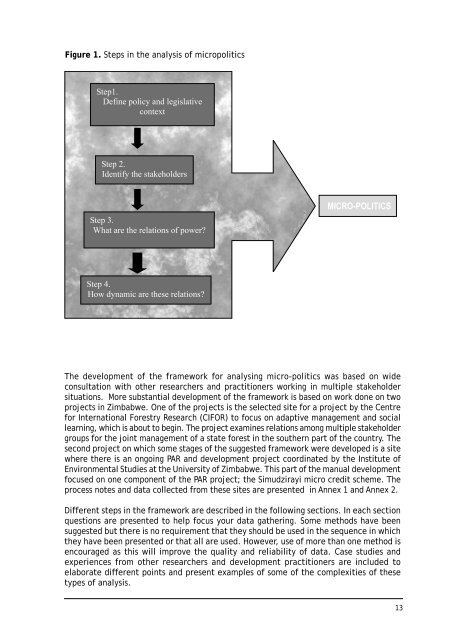Where the power lies: multiple stakeholder politics over natural ...
Where the power lies: multiple stakeholder politics over natural ...
Where the power lies: multiple stakeholder politics over natural ...
Create successful ePaper yourself
Turn your PDF publications into a flip-book with our unique Google optimized e-Paper software.
Figure 1. Steps in <strong>the</strong> analysis of micro<strong>politics</strong><br />
The development of <strong>the</strong> framework for analysing micro-<strong>politics</strong> was based on wide<br />
consultation with o<strong>the</strong>r researchers and practitioners working in <strong>multiple</strong> <strong>stakeholder</strong><br />
situations. More substantial development of <strong>the</strong> framework is based on work done on two<br />
projects in Zimbabwe. One of <strong>the</strong> projects is <strong>the</strong> selected site for a project by <strong>the</strong> Centre<br />
for International Forestry Research (CIFOR) to focus on adaptive management and social<br />
learning, which is about to begin. The project examines relations among <strong>multiple</strong> <strong>stakeholder</strong><br />
groups for <strong>the</strong> joint management of a state forest in <strong>the</strong> sou<strong>the</strong>rn part of <strong>the</strong> country. The<br />
second project on which some stages of <strong>the</strong> suggested framework were developed is a site<br />
where <strong>the</strong>re is an ongoing PAR and development project coordinated by <strong>the</strong> Institute of<br />
Environmental Studies at <strong>the</strong> University of Zimbabwe. This part of <strong>the</strong> manual development<br />
focused on one component of <strong>the</strong> PAR project; <strong>the</strong> Simudzirayi micro credit scheme. The<br />
process notes and data collected from <strong>the</strong>se sites are presented in Annex 1 and Annex 2.<br />
Different steps in <strong>the</strong> framework are described in <strong>the</strong> following sections. In each section<br />
questions are presented to help focus your data ga<strong>the</strong>ring. Some methods have been<br />
suggested but <strong>the</strong>re is no requirement that <strong>the</strong>y should be used in <strong>the</strong> sequence in which<br />
<strong>the</strong>y have been presented or that all are used. However, use of more than one method is<br />
encouraged as this will improve <strong>the</strong> quality and reliability of data. Case studies and<br />
experiences from o<strong>the</strong>r researchers and development practitioners are included to<br />
elaborate different points and present examples of some of <strong>the</strong> complexities of <strong>the</strong>se<br />
types of analysis.<br />
13

















